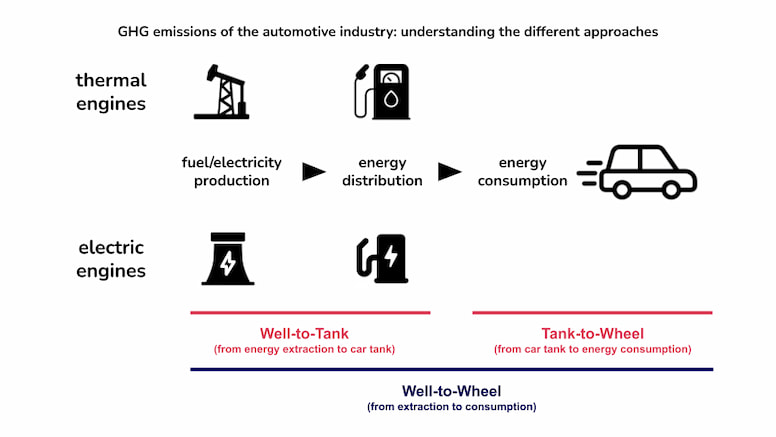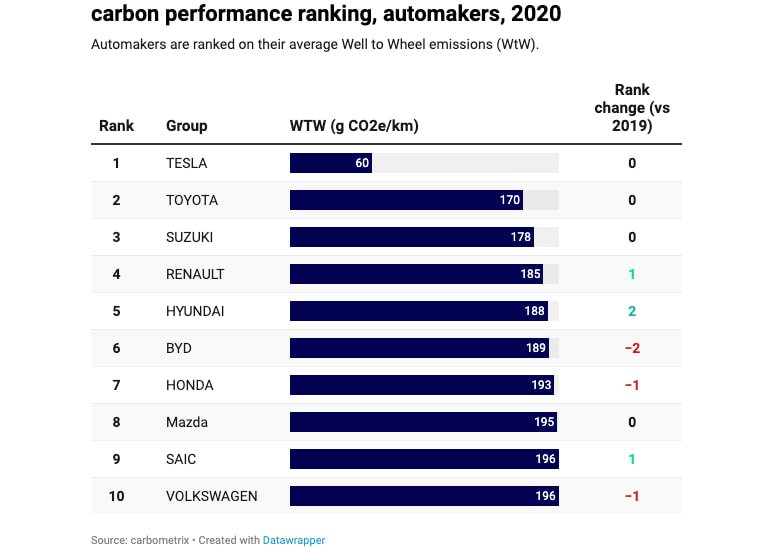We have analyzed and computed the carbon emission performance of 48 automakers representing 70 million cars sold in 2020, or 99% of worldwide sales.
Our previous article set the context on why greenhouse gas emissions are a top priority issue for automakers. We explained what matters in their carbon footprint and how to assess their carbon performance using physical intensity metrics: physical intensity, expressed in gCO2e/km, represents the quantity of CO2e emitted per kilometre driven by the car.
This article presents the results of our independent assessment of the carbon performance of car makers.
Why this ranking?
At Carbometrix, we favour a full life cycle approach of the energy required to drive the vehicle (well-to-wheel) to assess car manufacturer performance rather than the partial tank-to-wheel one. Indeed, the well-to-wheel methodology not only accounts for emissions when the car is used but also for carbon impacts from the production of electricity and the extraction and processing of fossil fuels.

Electric and hybrid vehicles models are often said to be carbon neutral. However, producing electricity to power the car is not carbon neutral. Emissions from electricity production depend on the primary sources of energy used (eg. fossil fuels, nuclear power, renewable energies, etc.) and varies greatly by countries.
International norms fail to account for carbon emissions of cars using grid electricity. Norms take into account tank-to-wheel emissions, as opposed to well-to-wheel emissions.
Our methodology takes into account carbon intensity of electricity production in countries where cars are sold. The resulting ranking provides the most accurate pictures of CO2 emissions performance of automakers.
Ranking
We selected the top 25 automakers, which represent 96% of the global market. Amongst them, we show the ten best performers using their well-to-wheel physical intensity performance expressed in gCO2e/km.

Tesla is the least emissive car manufacturer per unit of product sold as it only sells electric cars. Most of Tesla’s sales are in the US, where electricity production relies on fossil fuels which explains the 60 gCO2e/km intensity.
The second one, Toyota benefits from its large share of hybrid vehicles, whose tank-to-wheel intensity is lower than thermal cars. Overall, automakers improve their performance by increasing their share of hybrid and electric vehicles and producing vehicles with a lower tank-to-wheel intensity.
Renault is the first European automaker in the ranking, reaching 4th position. Hyundai, BYD, Honda, and Mazda are close behind.
As Chinese electricity is very carbon-intensive, BYD ranks in the middle of the chart, despite its important share of electric vehicles (31%).
The ranking varies slightly compared to 2019, especially at the bottom, while the top 3 remain the same.
Conclusion
The automotive sector accounted for 8% of the total human-induced GHG emissions in 2020. Decarbonising this industry will be key in achieving the goal set by the 2015 United Nations Paris Agreement of “holding the increase in the global average temperature to well below 2 °C above pre-industrial levels”. Car manufacturers must keep on improving their carbon footprint by producing energy-efficient car models.
With the exception of Tesla and BYD, all car manufacturers have a low share of electric vehicle sales. As we move to a low-carbon transportation system, today’s big players risk losing market share to disruptors unless they rapidly scale up their low-carbon vehicle sales.
As the share of electric vehicles increases, the well-to-wheel approach will become more important, to assess automakers carbon performance. International norms must evolve to account for the electrification of the world car fleet and use well-to-wheel instead of tank-to-wheel.
The ranking presented here is solely based on greenhouse gas emissions, which is Carbometrix’s focus. While carbon reduction is absolutely necessary to address climate change, there are other critical issues such as scarcity of metal resources in the energy transition. The impact of production processes on finite resources, ecosystems and biodiversity must also be closely watched to ensure the most appropriate response to climate change.
The section below details our methodology and its limitations.
Methodology
We rank companies according to their carbon performance. Carbon performance refers to the greenhouse gas emissions per product or service sold. It tells about the ability of a company to produce and sell with minimum greenhouse gas emissions per unit of product sold.Because there are major discrepancies in the way companies all over the world account for their GHG emissions, we use an asset based and data science driven methodology and do not rely on companies sustainability report and GHG disclosure. We independently compute company carbon footprint and carbon performance indicators. This methodology makes the ranking homogeneous, reliable and independent of companies’ self-declared GHG emissions. We do not seek high precision instead we make sure to compute a like for like comparison of companies.Our asset-based methodology for the auto sector relies on
Sales of vehicles worldwide country per country and model per model
Model specifications (engine type, WLTP, weight…)
To compute an automaker’s carbon performance, we associate each model to a brand and each brand to its auto manufacturer. The ranking reflects three elements:
The share of electric, hybrid, and plug-in hybrid vehicles in total sales, as these models are less emissive than thermal cars.
The fuel efficiency of thermal and hybrid vehicles produced. Heavier cars need more fuel to drive the same distance and emit more CO2.
The carbon intensity of electricity production in the countries where the electric and hybrid models are sold. It is included in the well-to-tank emissions. We have applied typical emission factors for the well-to-tank emissions of thermal cars (e.g., oil extraction, processing, and transportation).
To account for the well-to-wheel intensity of each automaker, we calculated:
Their tank-to-wheel emissions, i.e., emissions of fuel once in the car. We used official WLTP emissions. This EU vehicle homologation protocol provides accurate and comparable emissions data for different car models.
We account for the carbon intensity of electricity production in the countries where electric and plug-in hybrid cars are sold.
Limitations of the model
We seek comparability rather than precision in assessing companies’ carbon performance. This results in the following limitations:
We depend on the WLTP norm. It provides us with comparable emissions data for all car models. It is complicated to consider all parameters to calculate CO2 emissions from driving, and as such, the test is imperfect. It is, however, a good proxy, recognized by several international institutions.
The WLTP norm considerably underestimates hybrid cars emissions. For instance, the WLTP norm does not account for emissions from battery charging. However, the NGO Transport Environment finds that these emissions are too significant to be ignored and should be included in calculations.
We have not been able to match all car models’ emissions with their manufacturers’ sales. When this happened, we used mean emissions for similar cars from the same manufacturers.
Some automakers provided unusable data. For instance, the Hyundai-Kia group did not differentiate electric, hybrid, and plug-in hybrid vehicles in its sales.
In the case where we could not access data on sales, we used data on production.
Sources
ADEME https://www.ademe.fr/
Companies annual and sustainability reports
EEA https://www.eea.europa.eu/fr
Enerdata https://www.enerdata.fr/
GHG protocol standard https://ghgprotocol.org/
ICCT https://theicct.org/
IPCC https://www.ipcc.ch/
LEI database https://search.gleif.org/#/search/
Mark lines https://www.marklines.com/portal_top_en.html
Automobile Club Luxembourg: https://www.acl.lu/getmedia/a5db9a90-bca3-4f4c-98f5-e2ba26935425/Liste-vehicules-electrifies.pdf
xiaoxiongyouhao: http://www.xiaoxiongyouhao.com/
